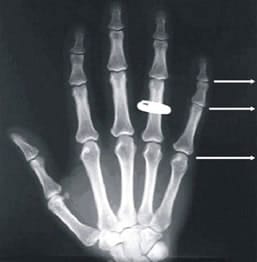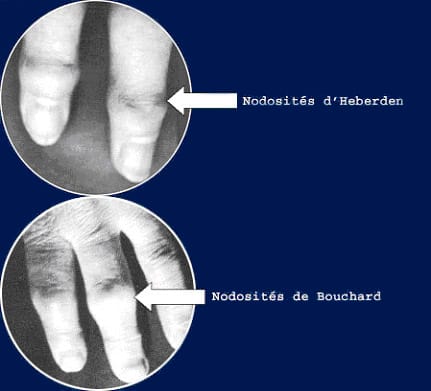Osteoarthritis of the hand develops most frequently in women around the age of the menopause.
Osteoarthritis of the fingers needs to be dissociated from rhizarthrosis.
 |
Distal interphalangeal joints (DIP) Proximal interphalangeal joints (PIP)
Metacarpophalangeal joints (MCP) |
Rhizarthrosis affects the base of the thumb ("rhiz" signifying root of the thumb). It affects the joint between the trapezium and first metacarpal.
Very common, it most often affects women around the age of 50. Osteoarthritis often develops on both sides at different stages. However, the dominant hand is most often affected.
In contrast to digital osteoarthritis, the difficulties in this location are much more functional than aesthetic. But rhizarthrosis can be associated with osteoarthritis of the fingers
Osteoarthritis of the fingers
Osteoarthritis of the fingers is very common. It usually begins at around the age of 50, affects women more frequently and is often exacerbated at the time of the menopause.
It affects mainly the distal interphalangeal joints (DIP) forming Heberden's nodes. Involvement of the proximal interphalangeal joints (PIP) is rarer; it creates the appearance of Bouchard's nodes. The metacarpophalangeal joints are very rarely affected.
|
|
 |
|
Genetic factors are very significant; mother-daughter heredity is very common. In addition, a person suffering from digital osteoarthritis, often suffers from osteoarthritis in other joints. (Polyarthrosis);
erosive osteoarthritis of the fingers is a rare form of the disease. It affects the distal and medium-sized joints Compared to other types of osteoarthritis of the fingers it corresponds to a clinical form whose symptoms are significant as soon as they arise, combining local inflammatory signs and pain. It begins by reaching the PIP and then affects the DIP and finally the MCP and can even extend to the thumbs.






